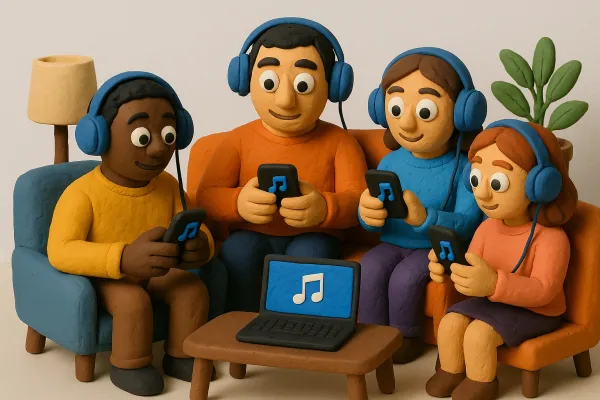Can Artists See Playlists on Spotify? Unveiling the Truth Behind Artist-Listener Connections

As a musician, you might wonder about the connections you have with your listeners on Spotify. One big question is whether artists can see playlists that feature their songs. This article digs into that curiosity, exploring how artists can access data about their music and understand their audience better. Let's unravel the truth behind artist-listener connections on Spotify.
Key Takeaways
- Artists can't see the specific identities of their monthly listeners due to privacy policies.
- Spotify provides analytics that show how songs perform on playlists, helping artists strategize.
- Monthly listeners reflect unique users interacting with an artist's music over a month.
- Understanding demographic data helps artists tailor their music and marketing efforts.
- Playlist placements can significantly boost an artist's exposure and potential success.
Can Artists See Playlists That Feature Their Music?
Understanding Playlist Visibility
We always wondered how much we really know about where our songs end up. Sometimes, it feels like music takes on a life of its own and finds its way into unexpected playlists. But here's the scoop: artists don't have a backstage pass to every playlist featuring their tunes. We get some clues from data, like which playlists are buzzing with streams, but not a full guest list.
For a quick view, check out this table that breaks down different playlist types:
| Playlist Type | Visibility Level |
|---|---|
| Editorial Playlists | Some insights available |
| User Playlists | Hidden from direct view |
| Algorithmic Picks | Stats show partial exposure |
The Role of Spotify's Algorithm
When we think about how our music reaches listeners, we have to talk about Spotify's algorithm. The platform works behind the scenes to match songs with the right playlists. It's not entirely random, and yes, we get a peek at some of the data. But remember, there’s still a lot of mystery left in there. The algorithm decides which tracks gain traction, and sometimes we see patterns like increased streams coming from Release Radar displays picks. Here’s what we generally notice:
- A surge in playlist adds over a short period
- Increased overall listens once on a popular playlist
- Shifts in listener habits reflecting playlist curation
How Artists Can Track Playlist Performance
We often track how our songs perform using the tools available on Spotify. This dashboard gives us numbers that are pretty telling, even if it doesn’t reveal every detail about who added our songs to a playlist. The data is enough to help us make informed decisions about our releases and marketing efforts.
Sometimes, even if we don’t have the full picture, the numbers let us know when something’s working or when we need to rethink our approach.
We measure key stats like streaming counts and listener retention from each playlist. With a few simple steps, we can gauge which playlists are really bringing our tunes to life:
- Monitor the increase in play counts after a new playlist inclusion
- Compare performance across different playlist types
- Use these insights to shape our next move in music promotion
Each piece of data sparks new ideas on how we can better connect with our fans. By keeping an eye on these trends, we adjust our strategy and keep the rhythm going.
What Data Do Artists Get From Spotify?
Spotify shares a bunch of numbers and trends with us, which makes our everyday work feel a bit more like a puzzle to solve. It helps us see what's really going on with our tracks, our fans, and our music journey.
Monthly Listener Insights
Every month, we get a snapshot of how many people are tuning in to our songs. This isn't just a number—it's a story. This data paints a vivid picture of our journey every month.
For instance, here’s a quick look at what the numbers might tell us:
| Metric | Count |
|---|---|
| Total Listeners | 8,000 |
| New Listeners | 1,200 |
| Returning Listeners | 3,500 |
These figures help us spot trends, decide when to drop new tracks, and even figure out if our last release was a hit or a miss. Plus, check out our Wrapped Insights to see how others are smiling at their monthly trends.
Demographic Breakdown
Understanding who our fans are is as important as the music itself. Spotify breaks things down by age, gender, and where people are from. This means we get a glimpse into the mix of listeners behind the numbers. Here are a few tidbits we pay attention to:
- Age groups and what they lean towards
- Geographical hotspots for our tunes
- Gender trends that might influence our sound choices
Every piece of demographic data guides us in tuning our music to match what our fans are getting into these days.
Engagement Metrics
It’s not just about who listens—it's about how they interact with our music. Spotify tracks things like stream counts, playlist adds, and even how often someone hits that repeat button. Such details let us know which songs stick and which ones might need a little push.
Some key points we watch for:
- Number of streams per track
- Playlist saves and shares
- Repeat listens and overall song engagement
These numbers may seem simple, but they truly help us refine our approach and connect with fans better.
The Mystery of Monthly Listeners
Our monthly listeners are more than just numbers on a screen. As a group, we often wonder about the real people behind these stats – who they are, how they make us feel, and what role they play in our career journey. In our experience, this isn’t just a metric; it’s a story that unfolds with every stream.
Who Are These Listeners?
We see these listeners as a diverse bunch. They come from different parts of the world, each with their own taste in music. Sometimes, it feels like an ever-changing mix that keeps us on our toes:
- A global fan base excited about new releases
- Casual listeners who drop in when something catchy comes up
- Hardcore fans who follow every tune we put out
Each of these groups adds a unique vibe to our music story. And yes, even Bruno Mars record shows that when artists hit big numbers, they capture the attention of fans everywhere.
How Monthly Listeners Impact an Artist's Career
It’s clear – the number of monthly listeners can shape our career in real ways. From booking shows to planning marketing moves, these figures often drive our decision-making process. Regular tracking of these numbers lets us better plan our next steps.
Here’s a simple table to break it down:
| Metric | Description | Impact on Career |
|---|---|---|
| Unique Plays | Count of individual plays in 30 days | Gauges reach |
| Demographic Data | Age and location breakdown | Helps plan tours |
| Engagement Rates | Frequency of listener interactions | Aids in fan retention |
We rely on this data to tweak our sound and connect more deeply with our audiences.
The Importance of Listener Anonymity
While it might be tempting to know every detail about who’s listening, privacy is key. We don’t see names or personal info, just the big picture. This means we base our strategies on solid, broad insights rather than specifics.
- We honor privacy by focusing on trends
- We use aggregated numbers to guide our releases
- We stay connected to our fan’s general mood and style
The anonymity of our listeners not only protects their privacy but creates a space where our creativity keeps flowing freely.
By understanding both the impact and limits of this data, we continue to grow and adapt in a way that feels right for everyone involved.
Navigating Spotify Analytics
Key Features of the Artist Dashboard
We spend a lot of time on our dashboard because it makes sense of all our numbers. Every time we log in, we see the essential stats like monthly streams, listener locations, and playlist adds neatly laid out. For instance:
- Monthly streams show our overall play counts in a month
- Listener demographics help us know where our fans are from
- Playlist adds indicate which lists are boosting our songs
The dashboard gives us a quick snapshot of our music's performance.
Below is a simple table summarizing some favorite metrics:
| Metric | What It Tells Us |
|---|---|
| Monthly Streams | Total plays in a month |
| Listener Geography | Arrival points of our fans |
| Playlist Adds | Number of playlists featuring our tracks |
Using Data to Connect with Fans
We love using the dashboard as a chat window into our fans’ world. Checking out the numbers shows us which songs hit the mark and which ones might need a little tweaking. The data gives us hints about when and where to engage more deeply.
We try to keep our connection genuine, using every bit of feedback from streaming numbers to plan social posts and even live sessions.
Plus, we often tap into our favorite all-in-one tool to get real-time insights that drive our creative choices.
Strategies for Growth Based on Analytics
With the data at hand, we plan our moves like a team mapping out a game strategy. Here’s how we use these insights:
- We adjust our release timings to match peak listening hours.
- We experiment with different song versions and styles based on skip and save rates.
- We organize local gigs in areas with strong listener presence.
These steps come from the daily tweaks we make after reviewing our numbers, and they keep us on track toward getting our music heard by more people.
The Impact of Playlists on Artist Success
How Playlists Boost Exposure
We keep seeing that playlist placements are a big deal for us. When our song lands in a playlist, it isn’t just about a boost in streams; it’s about getting our music in front of a whole new group of listeners. We notice a clear jump in plays, and it’s all thanks to the extra exposure we get. For example, tools like Spotify Wrapped let us review how our tracks perform over time.
- Our songs reach listeners who might not follow us directly.
- Each playlist act as a mini radio station playing our music non-stop.
- Increases our overall visibility and engagement.
The Difference Between Editorial and User-Generated Playlists
We see two main types of playlists: those picked by Spotify’s own team and those put together by our fans. Editorial playlists are usually carefully set up by professionals, meaning they have rules and a very broad reach. On the other hand, user-generated playlists are more personal; they reflect real listener tastes and often build closer bonds within a community. We sometimes check in on our progress with Spotify Wrapped to see how each type stacks up.
| Aspect | Editorial Playlists | User-Generated Playlists |
|---|---|---|
| Curation | Set by Spotify experts | Created by everyday listeners |
| Audience Reach | Wide and varied | More niche and focused |
| Impact on Success | Big boost in exposure | Fosters tighter fan communities |
Maximizing Playlist Opportunities
We make it a point to chase every chance to get our music on the right playlists. A few steps that we follow regularly include:
- Checking which playlists bring in the most consistent plays.
- Reaching out to curators with a quick, personalized note.
- Testing different song versions to see what fits best into playlist vibes.
This method has increased our streams and deepened our fan connections. We also turn to insights like those from Spotify Wrapped to spot trends and keep our approach fresh.
Our experience shows that strategic playlist submissions don’t just boost our numbers—they help grow our community into a more engaged and loyal group of listeners.
Privacy Policies and Listener Data
Understanding User Privacy on Spotify
We often think about how our personal data is handled on Spotify. When we use the app, we notice that privacy is taken seriously—our habits and location remain ours. For instance, while aggregate data gives artists a sense of overall trends, our exact listening details aren’t shared. This is one way listener privacy is maintained. Here’s a quick breakdown of how data is usually treated:
| Data Type | Handling Method |
|---|---|
| Listening Patterns | Summarized and anonymous |
| Location Info | Generalized ranges |
| Engagement Stats | Broad trends only |
What Artists Can and Can't See
From our side, it's cool to see that artists only get a limited snapshot of their audience. They can track overall numbers and trends but not our personal details. This keeps our individual listening habits safe. We generally observe that:
- Artists see total counts like monthly listeners.
- Detailed personal data stays hidden.
- They only access broad demographics and summarized stats.
The Balance Between Data and Privacy
We believe it’s important to keep a fair balance between offering useful data to artists and protecting our own information. In our view, achieving this balance means:
- Clear rules on data sharing.
- User consent processes that ensure we know what’s collected.
- Regular updates to policies based on feedback and regulation changes.
We’re comfortable knowing that while artists get enough info to understand their audience, our privacy remains a top priority. This balance helps both creators and listeners feel secure.
At PlaylistHub, we care about your privacy and how we handle your data. We want you to feel safe while enjoying our services. If you want to learn more about our privacy rules and how we protect your information, visit our website today!
Wrapping It Up: The Artist-Listener Connection on Spotify
So, can artists see who’s jamming to their tunes on Spotify? Not exactly. While they can’t pinpoint individual listeners, they do get a treasure trove of data about their audience. This includes stats on where fans are from, their age, and what other artists they dig. It’s like having a backstage pass to understanding their fanbase without invading anyone’s privacy. This info helps artists tweak their music and marketing to connect better with listeners. In the end, it’s all about building that relationship, even if it’s a bit mysterious. So, keep streaming and supporting your favorite artists—they’re out there, trying to figure out how to reach you better!
Frequently Asked Questions
Can artists see who listens to their music on Spotify?
No, artists can't see the names of their listeners. They can only see general information about their audience.
What kind of data does Spotify give to artists?
Spotify shares data like how many people listen to their music each month, where those listeners are from, and their age and gender.
How do monthly listeners affect an artist's career?
Monthly listeners show how popular an artist is and can help them attract more fans and opportunities.
What tools do artists have to analyze their performance on Spotify?
Artists can use the Artist Dashboard, which provides insights into streams, listener demographics, and engagement metrics.
Do playlists really help artists gain more listeners?
Yes, being on playlists can increase an artist's visibility and lead to more streams and followers.
How does Spotify protect listener privacy?
Spotify keeps listener identities private, so artists only see anonymous data and can't know who their listeners are.





